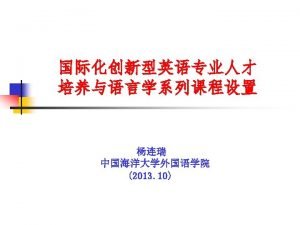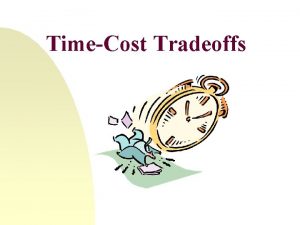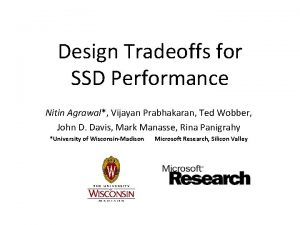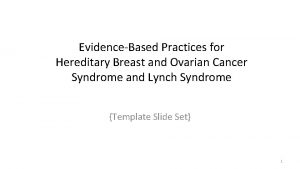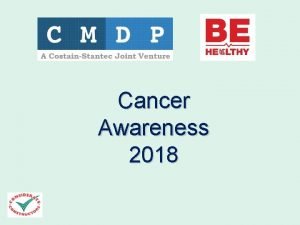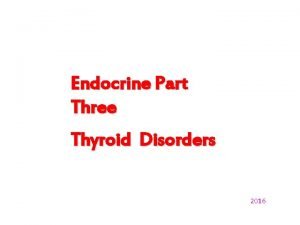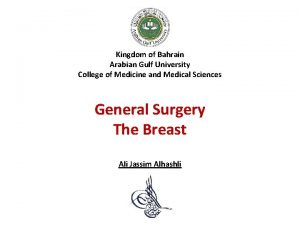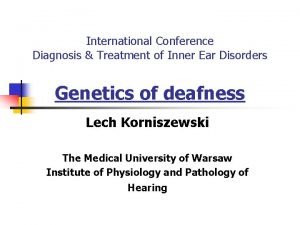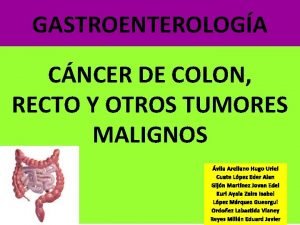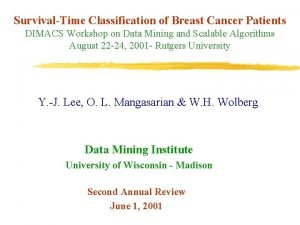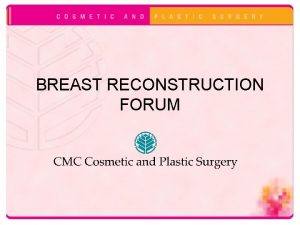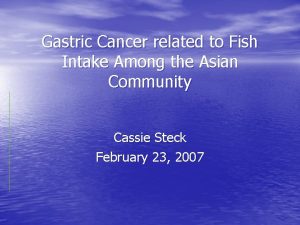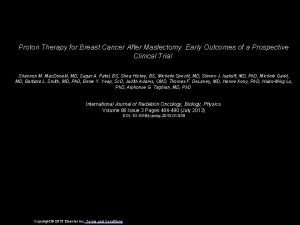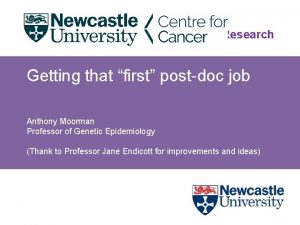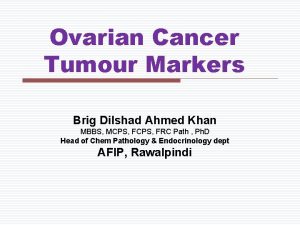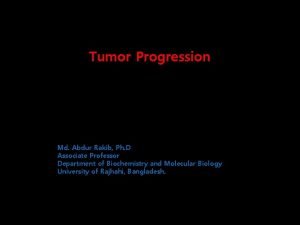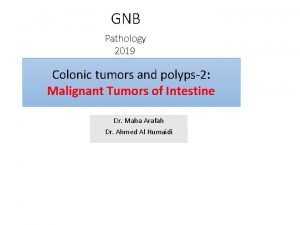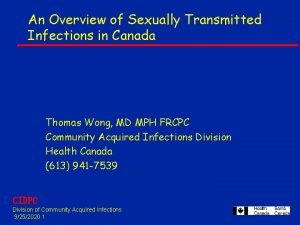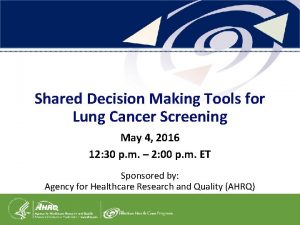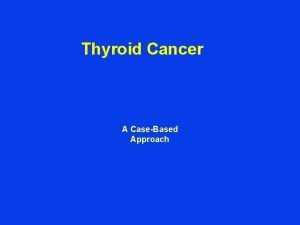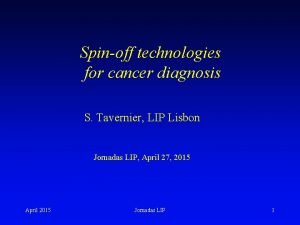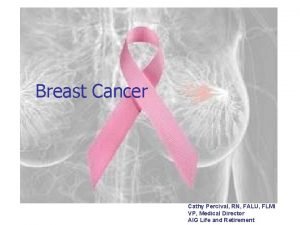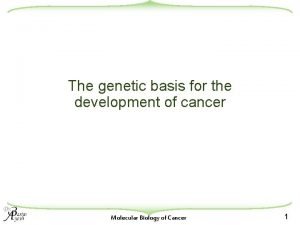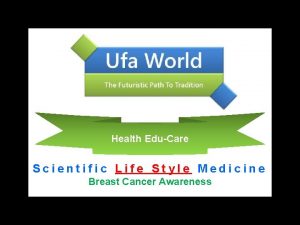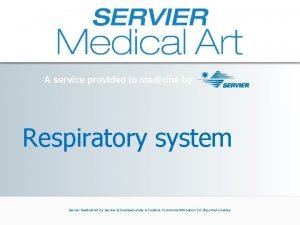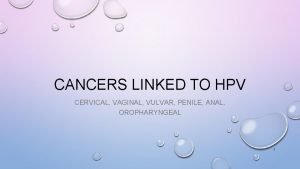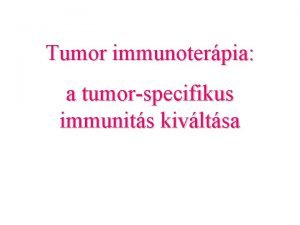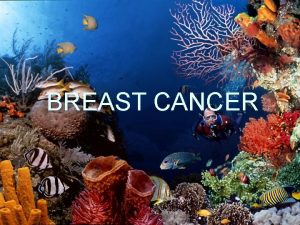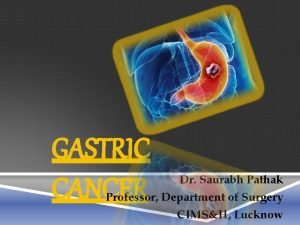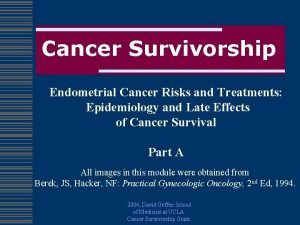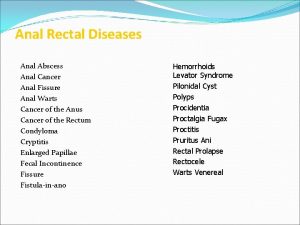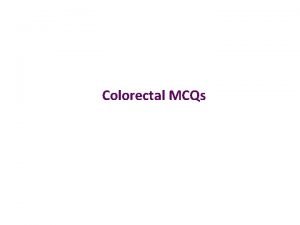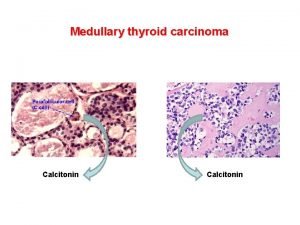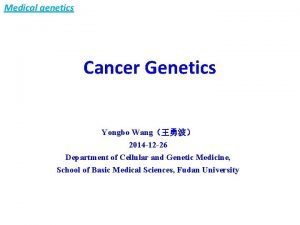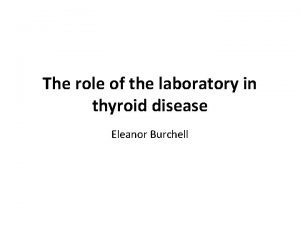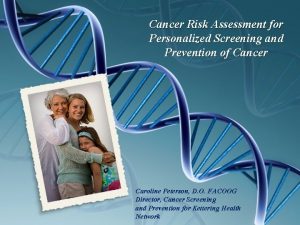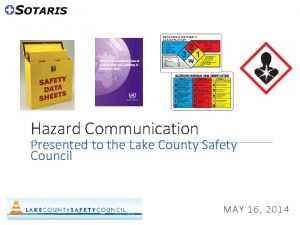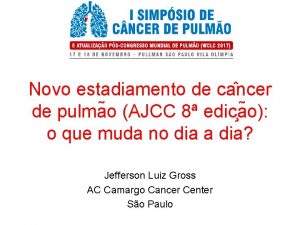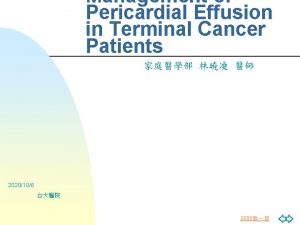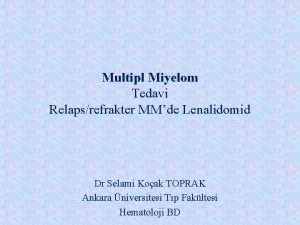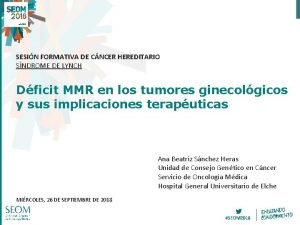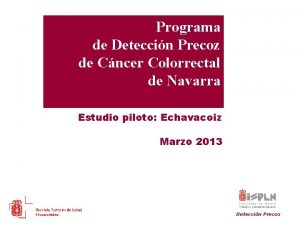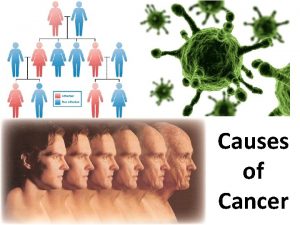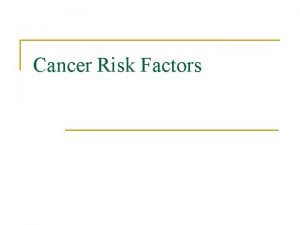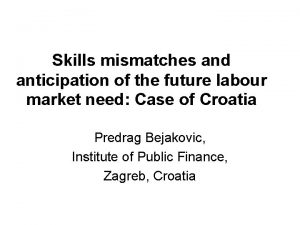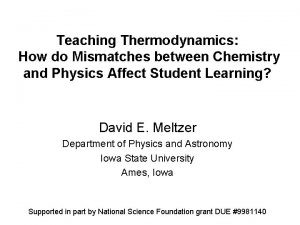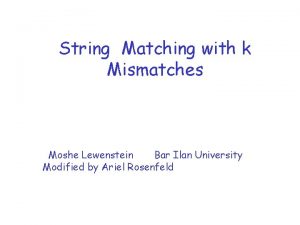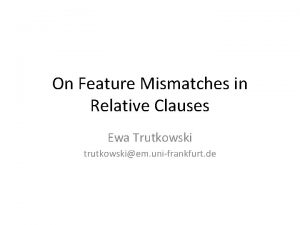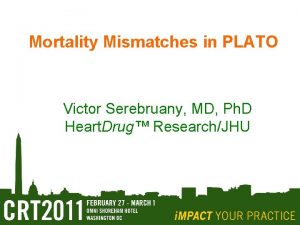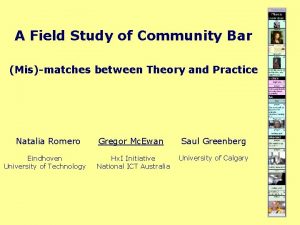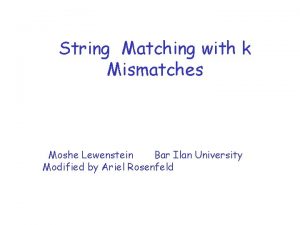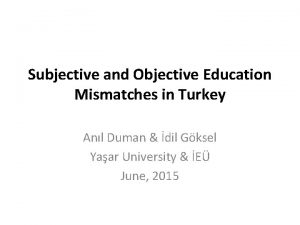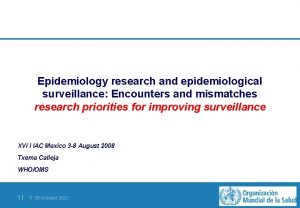CANCER focus on tradeoffs mismatches evolution of causes
































































- Slides: 64

CANCER: focus on tradeoffs, mismatches, evolution of causes & *somatic evolution within the body*

Evolutionary biology of cancer SEVEN PRINCIPLES OF EVOLUTION & CANCER (1) Cancer is mediated by somatic evolution (2) Cancer is many tissue-specific and age-associated diseases, with one commonality in uncontrolled cell replication (3) The somatic evolution of cancer is mediated by the population-genetic forces of mutation, selection & genetic drift, in a phylogenetic, phylogeographic context (4) Cancer is a polygenic, heritable, and environmental disease, mediated in part by mismatches between current and ancestral conditions (5) The ultimate causes of cancer involve evolutionary tradeoffs & co-option of normal evolved functions involving growth, maintenance, and reproduction (6) Anticancer adaptations have evolved (7) Cancer cell populations evolve in response to therapies

Genetic, epigenetic, genomic, and cytogenetic changes Your somatic cell lineages YOU SOMATIC EVOLUTION birth DS LUTION I K UR VO YO GE INE L M R E

Frank, 2010, PNAS

Evolutionary biology of cancer SEVEN PRINCIPLES OF EVOLUTION & CANCER (1) Cancer is mediated by somatic evolution (2) Cancer is many tissue-specific and age-associated diseases, w/ one commonality in uncontrolled cell replication (3) The somatic evolution of cancer is mediated by the population-genetic forces of mutation, selection & genetic drift, in a phylogenetic, phylogeographic context (4) Cancer is a polygenic, heritable, and environmental disease, mediated in part by mismatches between current and ancestral conditions (5) The ultimate causes of cancer involve evolutionary tradeoffs & co-option of normal evolved functions involving growth, maintenance, and reproduction (6) Anticancer adaptations have evolved (7) Cancer cell populations evolve in response to therapies

The simplest definition is from the American Cancer Society (ACS). According to the ACS, cancer is a group of diseases characterized by uncontrolled growth and spread of abnormal cells. If the spread is not controlled, it can result in death The Hallmarks of Cancer, all of which evolve somatically (1) self-sufficiency in growth signals (2) insensitivity to anti-growth signals (3) evading apoptosis (4) sustained angiogenesis (5) limitless replicative potential (6) invasion and metastasis (7) escaping immunosurveillance


Some cancer terminology Classification by tissue type: Classification by the type of cells: • carcinoma • Adenomatous cells epithelial cell 90% of all tumours derived from ectoderm (mostly) or endoderm (some) • sarcoma connective tissue 2% of all tumours derived from mesoderm • leukaemia circulatory or lymphatic 8% of all tumours derived from mesoderm ductal or glandular cells • Squamous cells flat cells • Myeloid blood cell • Lymphoid lymphocytes or macrophages Cancer is many diseases with one commonality

Childhood cancers differ from adult cancers Classification by tissue type: • carcinoma epithelial cell 90% of all tumours derived from ectoderm (mostly) or endoderm (some) • sarcoma connective tissue 2% of all tumours derived from mesoderm • leukaemia circulatory or lymphatic 8% of all tumours derived from mesoderm MOST ADULT CANCERS (stem cells, progenitor cells, de-differentiation, increased risk with age) MOST CHILDHOOD CANCERS (failures of differentiation, other losses of replication control, decreased risk with age except for osteosarcoma)

‘Types’ of genes that undergo alterations in cancer I (1) ‘ONCOGENES’ -undergo dominant gains of function (e. g. , increased activity or higher expression of gene product) -often involved in stimulating cell replication (eg IGF 2) (2) ‘TUMOR SUPPRESSOR’ GENES -undergo losses of function via genetic or epigenetic inactivation, such that cell survival, replication are less controlled; loss of one copy may have no or minor effects, loss of both copies is major alteration -often involved in cell cycle regulation (eg RB 1, CDKN 1 C) NOTE: (a) all of these genes generally have OTHER primary functions (b) genes may be tumor suppressor or oncogene in one tissue, at one time point, NOT in other (c) effects of such genes are subject to TRADEOFFS w/ other functions

H 19 gene product: normal primary function: in placenta, restricts growth and cell migration, and regulates angiogenesis under hypoxic conditions; promotes differentiation of cytotrophoblast cells; also regulates post-natal growth ADAPTIVE FUNCTIONS • Acts as growth restraint/tumor suppressor gene PNAS 2008 *If P 53 suffers loss of function, then H 19 acts as an oncogene in hypoxic environment of tumors Bioch Biophys Acta 2010 MALADAPTATIVE FUNCTION

‘Types’ of genes that undergo alterations in cancer II (1) GATEKEEPER GENES: genes that regulate growth and differentiation; include oncogenes and tumor suppressor genes (2) CARETAKER GENES: genes that help to maintain genetic integrity; their loss of function mutations lead to -microsatellite instability (due to mismatch repair deficiency) -chromosomal instability (gain or loss of chromosomes or parts thereof) (3) LANDSCAPER GENES: genes that when mutated lead to abnormal extracellular or intracellular environment that contributes to carcinogenesis

Adult Cancer Risk Increases with Age (~40% get it, in lifetime) due to (1) sequential accumulation of mutations over a long time (2) senescence-related tissue changes that can promote cancer development

Pediatric Cancer Risk decreases with age & parallels growth velocity; 2 nd leading cause of child death in developed countries osteosarcoma Crespi 2011 PRSLB

Evolutionary biology of cancer SEVEN PRINCIPLES OF EVOLUTION & CANCER (1) Cancer is mediated by somatic evolution (2) Cancer is many tissue-specific and age-associated diseases, with one commonality in uncontrolled cell replication (3) The somatic evolution of cancer is mediated by the population-genetic forces of mutation, selection & genetic drift, in a phylogenetic, phylogeographic context (4) Cancer is a polygenic, heritable, and environmental disease, mediated in part by mismatches between current and ancestral conditions (5) The ultimate causes of cancer involve evolutionary tradeoffs & co-option of normal evolved functions involving growth, maintenance, and reproduction (6) Anticancer adaptations have evolved (7) Cancer cell populations evolve in response to therapies

populations cancer cells

Somatic evolution of cancer cell populations (1) Stepwise, nested generation of hierarchical among-cell genetic, epigenetic, cytogenetic diversity leading to evolution of six hallmarks of cancer via mutation, epimutation, chromosomal alterations; evolution in response to selective pressures including immune system, ‘competition’ between cells, ‘cooperation’ between cancer cell lineages Origin of genomic instability, leading to much higher mutation rate (2) Evolution of cancer cell populations in response to therapeutic agents

CANCER CELLS EVOLVING BY NATURAL SELECTION • Variation in the population of cells: – • Somatic mutations. Variation amongst cells is Heritable: – • Mutations in DNA, chromosomes, methylation patterns. Variation affects Reproduction and Survival of the cells: – e. g. , suppression of apoptosis etc. ‘ADAPTATION? ’ sort of, but not in usual sense

Evolution Within a Neoplasm neutral Frequency within the Neoplasm neutral p 16+/- p 53 - p 16 -/- CANCER p 53 HGD Time

Cancer cells evolve via genetic, epigenetic, genomic and cytogenetic changes in large numbers of genes CLASSIC LINEAR MODEL:

But classic, unitary linear model fails due to high diversity of genetic, epigenetic, cytogenetic pathways whereby the hallmarks of cancer can be acquired

One example of progression to cancer

One example of progression to cancer Constant population

One example of progression to cancer ‘Advantageous’ ‘driver’ mutant (increases net proliferation of lineage) - in any number of genes; genetic, epigenetic or chromosomal

Clonal expansion

Saturation

Another ‘advantageous’ mutant

Wave of clonal expansion

How Might Diversity Change During Progression? Genetic, Phylogenetic and Demographic Change Lineages Number of Clones Divergence Waves of Clonal Expansion Population Subdivisions No Selective Sweeps

The results of cancer cell population-level evolution, for two patients Other patients? Other cancers? Regularities, for therapeutic targets? PNAS 2008

Population Genetics of Cancer: Rate of Evolution What is the probability of a new cellular/genetic variant emerging and expanding in a population? Function of: – – Mutation rate (rate of variant generation) Population size (numbers of mutational targets) Generation time (rate of turnover) Strength of selection (rate of clonal expansion) EFFECTS OF GENETIC VARIABILITY ON PROGRESSION ->

Genetic Diversity Predicts Progression Number of Clones, in Barrett’s esophagous Carlo Maley • Median: – – progressors 3 (range: 1 - 9) non-progressors 1 (range: 1 - 7) • RR = 1. 40 per clone (95% CI: 1. 13 - 1. 73) p < 0. 01 • Controlling for p 53 LOH, aneuploidy and tetraploidy Maley et al. (2006) Nat. Gen. 38: 468– 73 N=267

Genetic Diversity Predicts Progression Mean Pairwise Divergence Median: • – – progressors 7% (range: 0– 54%), non-progressors 0% (range: 0– 27%) • RR = 1. 45 per 10% divergence • (95% CI: 1. 08 - 1. 95) p < 0. 05 • Controlling for p 53 LOH, aneuploidy and tetraploidy Maley et al. (2006) Nat. Gen. 38: 468– 73 N=267

Your cell lineages Genetic, epigenetic, genomic, and cytogenetic changes SOMA LINE birth tic e n e g , E N I d e L t i r M e GER ion, inh t a i r a vo v o n de d n a

Evolutionary biology of cancer SEVEN PRINCIPLES OF EVOLUTION & CANCER (1) Cancer is mediated by somatic evolution (2) Cancer is many tissue-specific and age-associated diseases, with one commonality in uncontrolled cell replication (3) The somatic evolution of cancer is mediated by the population-genetic forces of mutation, selection & genetic drift, in a phylogenetic, phylogeographic context (4) Cancer is a polygenic, heritable, and environmental disease, mediated in part by mismatches between current and ancestral conditions (5) The ultimate causes of cancer involve evolutionary tradeoffs & co-option of normal evolved functions involving growth, maintenance, and reproduction (6) Anticancer adaptations have evolved (7) Cancer cell populations evolve in response to therapies

Heritabilities 10 -50% depending on form of cancer Galvan et al. 2010 Trends Genet. -Many common alleles of small effect found by GWAS -Small % of heritability ‘explained’ so far -Rare variants being studied now -High genetic heterogeneity likely Hematology/Oncology Clinics of North America -Epigenetics virtually unstudied Volume 24, Issue 5, October -Gene x Env’t interactions unstudied 2010, Pages 973 -996

Visualizing inherited geneticallybased risk (‘closer to’ vs ‘farther from’ cancer at conception) Allele frequencies vs effect sizes of risk alleles Crespi 2011, Evol. Appl.

Genetic PLUS Environmental impacts; showing importance of chance mutational events Greaves 2007 Nat Rev Cancer

How evolutionary mismatches can affect cancer risk * Greaves 2008

* Effects of mismatches between ancestral and current conditions on chronic disease risk * Eaton et al. 1994 QRB

Mismatches and female reproductive cancers I Eaton et al. 1994 QRB

Mismatches and female reproductive cancers II Eaton et al. 1994 QRB

Mismatches and female reproductive cancers III Eaton et al. 1994 QRB

Urology 2001

Evolutionary biology of cancer SEVEN PRINCIPLES OF EVOLUTION & CANCER (1) Cancer is mediated by somatic evolution (2) Cancer is many tissue-specific and age-associated diseases, with one commonality in uncontrolled cell replication (3) The somatic evolution of cancer is mediated by the population-genetic forces of mutation, selection & genetic drift, in a phylogenetic, phylogeographic context (4) Cancer is a polygenic, heritable, and environmental disease, mediated in part by mismatches between current and ancestral conditions (5) The ultimate causes of cancer involve evolutionary tradeoffs & co-option of normal evolved functions involving growth, maintenance, and reproduction (6) Anticancer adaptations have evolved (7) Cancer cell populations evolve in response to therapies

EXAMPLE: tradeoff between cancer and senescence mediated by effects of p 53 gene Judy Campisi, UC Berkeley

Cancer risk trades off with aging in mice p 53 alleles in this mouse strain: + = wild type - = loss of function m = mutation Tyner et al. 2002 Good news! The m allele appears to confer resistance to tumors (6% vs >45%) Bad News! The m allele appears to have a cost in terms of aging (die off sooner than p 53+/+ wild types)

EXAMPLE: Tradeoffs between cancer risk and risks of neurodegenerative diseases Schizophrenia, Huntington’s, Parkinson’s, Alzheimer’s Genetic basis: PARK 2 APC TP 53 ATM, etc ->identify pathways PLo. S Genetics 2010

EXAMPLE: CHILDHOOD GROWTH - CANCER TRADEOFF As seen, age-specific growth rate is positively associated with agespecific cancer risk in children Childhood cancer risk positively associated with higher birth weight, faster fetal growth See Crespi 2011 PRSLB

SELECTION ON TRADEOFFS: Rapid cell proliferation -growth/cancer -repair/proliferation/cancer -senescence/apoptosis/cancer DNA repair Apoptosis Senescence, Lifespan Cancer risk, rates

Placenta as 1 o genetic & developmental source of hallmarks of cancer; Co-option of placentally expressed pathways Ferretti et al. 2006 Hum Rep Update

‘Co-option’ of testis genes, pathways in carcinogenesis Family of X-linked, primate-specific cancer/testis associated genes (CTAs), expressed in normal testis, involved in spermatogenesis, and in tumor cells, promote cancer cell growth. Roles in spermatozoa development and function, cell cycle regulation, and apoptosis. Associated with aggressiveness of skin tumors, inherited testicular and prostate cancer risk. Kleene (2005) provides evidence that many CTAs (such as SPANX) are subject to extremely strong selection in the context of sperm production Cancer cells dedifferentiate and take on properties of immortal male germ cells. sperm function ‘HIJACKING’ of gene expression, functions, networks cancer risk

‘Co-option’ of gene expression patterns, pathways, cell/tissue phenotypes by cancer, from: -Placentation -Male germ cell proliferation (cancer/testis antigens) Stem cells Childhood growth systems (IGF 2, other genes) trade off with cancer risk Other reproductive tissues subject to rapid growth, strong selection Wound healing (cell migration, angiogenesis, local cell proliferation) EXPECT TRADEOFFS OF THESE CELL, TISSUE FUNCTIONS WITH CANCER RISK

Evolutionary biology of cancer SEVEN PRINCIPLES OF EVOLUTION & CANCER (1) Cancer is mediated by somatic evolution (2) Cancer is many tissue-specific and age-associated diseases, with one commonality in uncontrolled cell replication (3) The somatic evolution of cancer is mediated by the population-genetic forces of mutation, selection & genetic drift, in a phylogenetic, phylogeographic context (4) Cancer is a polygenic, heritable, and environmental disease, mediated in part by mismatches between current and ancestral conditions (5) The ultimate causes of cancer involve evolutionary tradeoffs & co-option of normal evolved functions involving growth, maintenance, and reproduction (6) Anticancer adaptations have evolved (7) Cancer cell populations evolve in response to therapies

Putative anti-cancer adaptations (1) proportions, separation, progression of stem cells, progenitor cells, differentiated cells (2) regenerative ability only in tissues that suffer damage (3) stem cells kept in separate compartments, to limit initial spread via microenvironment effects (4) cell division primarily in early fetal development, in relatively protected conditions (5) cellular senescence and apoptosis in response to DNA damage (6) immunosurveillance Crespi & Summers 2005, TREE

Colon tissue architecture Crypts of a colon

Colon tissue crypt architecture Gut Differentiated cells get shed off into the lumen Proliferating cells divide symmetrically and differentiate Stem cells replenish the tissue; asymmetric divisions

Evolutionary biology of cancer SEVEN PRINCIPLES OF EVOLUTION & CANCER (1) Cancer is mediated by somatic evolution (2) Cancer is many tissue-specific and age-associated diseases, with one commonality in uncontrolled cell replication (3) The somatic evolution of cancer is mediated by the population-genetic forces of mutation, selection & genetic drift, in a phylogenetic, phylogeographic context (4) Cancer is a polygenic, heritable, and environmental disease, mediated in part by mismatches between current and ancestral conditions (5) The ultimate causes of cancer involve evolutionary tradeoffs & co-option of normal evolved functions involving growth, maintenance, and reproduction (6) Anticancer adaptations have evolved (7) Cancer cell populations evolve in response to therapies

Traditional vs Targeted cancer drugs -Traditional drugs: very toxic agents that kill all dividing cells -Targeted drugs: small molecule inhibitors - target the specific pathways which make cancerous cells cancerous (e. g. , Gleevec inhibits a tyrosine kinase)

Targeted cancer drugs • Very effective • Not toxic • However, evolution of resistance poses a problem Mutation Gleevec Bcr-Abl protein

Genetic, epigenetic cytogenetic clonal heterogeneity evolve during carcinogenesis Drug treatments select for resistant clones, via different routes Cancer may undergo remission, but recurs Metastasis & resistance cause death Gerlinger & Swanton 2010 Br J Cancer

DATA: Therapies Select for Resistance Mutations • With 109– 1012 cells in a neoplasm and 104+ mutations, the presence of a resistance mutation is likely • Imatinib (Gleevec) resistance: – Point mutations in the kinase domain of BCR-ABL – Gorre & Sawyers. Curr. Opin. Hematol. 9: 303 -7 (2002) – Mutation present before therapy – Roche-Lestienne & Preudhomme. Sem. Hematol. 40: 80 -2 (2003) • Gefitinib resistance: – EGFR mutation – Kobayashi et al. NEJM 352: 786 -92 (2005) – MET amplification – Engelman et al. Science 316: 1039 -43 (2007) • 5 -fluorouracil resistance: TYMS amplification – - Wang et al. PNAS 101: 3089– 3094 (2004)

Implications of cancer somatic evolution, variation for therapy (1) Need to personalize treatment by genotyping the cancer; identify and target the driver mutations and the expected therapy-resistance mutations (2) Genotyping must involve sampling cancer cell population diversity (3) Evolutionary responses to therapies can be monitored (4) Cancer cells can be stabilized rather than maximally killed (reducing selection for evolution of resistant lineages) (5) Genomic instability can be increased to intolerable levels (6) Adaptive immune system and cancers can be manipulated to generate immune recognition of cancer cells (!)

Interested in career in cancer biology, using evolutionary concepts and tools? (1) Learn cell biology, cancer biology (2) Learn, apply genomic and bioinformatic tools, and/or collaborate (3) Consider an MD or MD-Ph. D (4) Develop and apply therapies based on evolutionary principles
 Minimize perceptual mismatches
Minimize perceptual mismatches Examples of tradeoffs
Examples of tradeoffs Scarcity forces tradeoffs
Scarcity forces tradeoffs Design tradeoffs for ssd performance
Design tradeoffs for ssd performance Actor focus vs object focus
Actor focus vs object focus For adult
For adult Integrated cost leadership/differentiation strategy
Integrated cost leadership/differentiation strategy Cost focus and differentiation focus
Cost focus and differentiation focus Syntactic sugar causes cancer of the semicolon
Syntactic sugar causes cancer of the semicolon Tobacco causes cancer
Tobacco causes cancer Symptoms of metal fume fever
Symptoms of metal fume fever Ovarian cancer causes
Ovarian cancer causes Welding causes cancer
Welding causes cancer Tobacco causes _______ of cancer deaths around the world. *
Tobacco causes _______ of cancer deaths around the world. * Tobacco causes cancer
Tobacco causes cancer Animal behavior biology
Animal behavior biology Proximate and ultimate causes of behaviour
Proximate and ultimate causes of behaviour Euthyroid hashimoto's
Euthyroid hashimoto's Gulf university
Gulf university Cancer biomedicine
Cancer biomedicine Ovarian cancer brca
Ovarian cancer brca Sigmoidectomia
Sigmoidectomia Bnox androrush cancer
Bnox androrush cancer Conclusion of breast self examination
Conclusion of breast self examination Forum tissue expander
Forum tissue expander Heliobactor
Heliobactor Nature reviews cancer
Nature reviews cancer Proton therapy for breast cancer after mastectomy
Proton therapy for breast cancer after mastectomy Northern institute for cancer research
Northern institute for cancer research Ca 125
Ca 125 Silica dust abatement
Silica dust abatement Cancer progression
Cancer progression Cancer genetic
Cancer genetic Hpv cervical cancer
Hpv cervical cancer Lung cancer screening shared decision making tool
Lung cancer screening shared decision making tool Thyroid cancer: a case-based approach
Thyroid cancer: a case-based approach Tavernier cancer
Tavernier cancer Carcinoma in situ
Carcinoma in situ Pluto planta
Pluto planta The genetic basis of cancer
The genetic basis of cancer Wwham ad
Wwham ad Chapter 24 the immune and lymphatic systems and cancer
Chapter 24 the immune and lymphatic systems and cancer Esmo guidelines thyroid cancer
Esmo guidelines thyroid cancer Breast cancer
Breast cancer Lung cancer location
Lung cancer location Hpv cervical cancer
Hpv cervical cancer Nutrition app cancer
Nutrition app cancer Nature reviews cancer
Nature reviews cancer Inflammatory breast cancer pictures
Inflammatory breast cancer pictures D1 d2 d3 gastrectomy
D1 d2 d3 gastrectomy Endometrial cancer
Endometrial cancer Perianal cancer
Perianal cancer Yp staging
Yp staging Calcitonin
Calcitonin Ddr prime cancer testimonials
Ddr prime cancer testimonials All about cancer
All about cancer Low t3 levels
Low t3 levels Family risk assessment example
Family risk assessment example Flame over circle symbol meaning
Flame over circle symbol meaning Estadiamento câncer de pulmão 8 edição
Estadiamento câncer de pulmão 8 edição Intrapericardial colon
Intrapericardial colon Colon cancer pathway
Colon cancer pathway Seer kidney cancer
Seer kidney cancer Clasificacion molecular cancer de endometrio
Clasificacion molecular cancer de endometrio Cancer colorrectal
Cancer colorrectal
